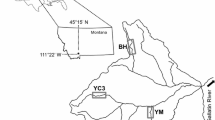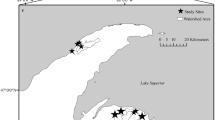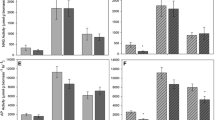Abstract
Nutrient uptake, storage, and release are critical ecosystem functions that affect carbon processing and food web dynamics. Yet, mechanisms controlling when ecosystems are net sinks or sources of nutrients are uncertain. Specifically, how nutrient supply ratios alter rates and ratios of net nutrient uptake and release is unclear. To assess whether net nitrogen (N) and phosphorus (P) uptake and release are linked to supply N:P, we experimentally enriched five forest streams at different N:P (target molar N:P range 2:1–128:1) for 2 years. We quantified net nutrient exchange (NNE) as the difference between the expected N and P fluxes assuming conservative transport (background concentrations plus experimental inputs) and the observed nutrient fluxes at the downstream end of each experimental stream reach. Supply N:P did not affect the magnitude of NNE for either N or P, but the likelihood of net N and P uptake was greatest at intermediate N:P supply (N:P = 99:1 and 55:1, respectively). Streams appeared to be highly flexible in their N:P uptake and release; the slopes between NNEN and NNEP within each stream increased with supply N:P. Furthermore, slopes comparing supply N:P to uptake and release N:P were near one (0.98 ± 0.06 SE and 0.82 ± 0.13 SE, respectively), indicating a high degree of flexibility. Overall, we found greater stoichiometric flexibility than has been shown in short-term nutrient-addition experiments. We suggest that this flexibility results from changes in nutrient recycling within biofilms or changes in community structure, which may take longer to manifest than the duration of shorter-term experiments.





Similar content being viewed by others
Data Availability
Data and code used for this paper are published through Zenodo and open access at: https://doi.org/10.5281/zenodo.7057891
References
Benstead JP, Rosemond AD, Cross WF, Wallace JB, Eggert SL, Suberkropp K, Gulis V, Greenwood JL, Tant CJ. 2009. Nutrient enrichment alters storage and fluxes of detritus in a headwater stream ecosystem. Ecology 90:2556–2566.
Brito EF, Moulton TP, De Souza ML, Bunn SE. 2006. Stable isotope analysis indicates microalgae as the predominant food source of fauna in a coastal forest stream, south-east Brazil. Austral Ecol 31:623–633.
Brookshire ENJ, Valett HM, Gerber S. 2009. Maintenance of terrestrial nutrient loss signatures during in-stream transport. Ecology 90:293–299.
Bumpers PM, Maerz JC, Rosemond AD, Benstead JP. 2015. Salamander growth rates increase along an experimental stream phosphorus gradient. Ecology 96:2994–3004.
Bumpers PM, Rosemond AD, Maerz JC, Benstead JP. 2017. Experimental nutrient enrichment of forest streams increases energy flow to predators along greener food-web pathways. Freshw Biol 62:1794–1805.
Carpenter SR, Chisholm SW, Krebs, Charles J, Schindler DW, Wright, Richard F. 1995. Ecosystem experiments. Science (80- ) 269:324–7.
Conley DJ, Paerl HW, Howarth RW, Boesch DF, Seitzinger SP, Havens KE, Lancelot C, Likens GE. 2009. Controlling eutrophication: Nitrogen and phosphorus. Science (80- ) 323:1014–5.
Covino T, McGlynn B, McNamara R. 2012. Land use/land cover and scale influences on in-stream nitrogen uptake kinetics. J Geophys Res Biogeosciences 117:G02006.
Cross WF, Benstead JP, Frost PC, Thomas SA. 2005. Ecological stoichiometry in freshwater benthic systems: recent progress and perspectives. Freshw Biol 50:1895–1912.
Cross WF, Rosemond AD, Benstead JP, Eggert SL, Wallace JB. 2006. Differential Effects of Consumers on C N and P Dynamics: Insights from Long-Term Research. In: de Ruiter P, Moore JC, Eds. Dynamic Food Webs, . Giessen, Germany: Academic Press. pp 235–247.
Danger M, Chauvet E. 2013. Elemental composition and degree of homeostasis of fungi: Are aquatic hyphomycetes more like metazoans, bacteria or plants? Fungal Ecol 6:453–457. https://doi.org/10.1016/j.funeco.2013.05.007.
Danger M, Daufresne T, Lucas F, Pissard S, Lacroix G. 2008. Does Liebig’s law of the minimum scale up from species to communities? Oikos 117:1741–1751.
Demi LM, Benstead JP, Rosemond AD, Maerz JC. 2018. Litter P content drives consumer production in detritus-based streams spanning an experimental N: P gradient. Ecology 99:347–359.
Fanin N, Fromin N, Buatois B, Hättenschwiler S. 2013. An experimental test of the hypothesis of non-homeostatic consumer stoichiometry in a plant litter-microbe system. Ecol Lett 16:764–772.
Finlay JC, Small GE, Sterner RW. 2013. Human influences on nitrogen removal in lakes. Science (80- ) 342:247–50.
Gelman A, Hill J. 2007. Data analysis using regression and multilevel/hierarchical models. Cambridge, UK: Cambridge University Press.
Godwin CM, Cotner JB. 2014. Carbon:phosphorus homeostasis of aquatic bacterial assemblages is mediated by shifts in assemblage composition. Aquat Microb Ecol 73:245–258.
Godwin CM, Cotner JB. 2015. Aquatic heterotrophic bacteria have highly flexible phosphorus content and biomass stoichiometry. ISME J 9:2324–2327.
Gulis V, Suberkropp K. 2003. Leaf litter decomposition and microbial activity in nutrient-enriched and unaltered reaches of a headwater stream. Freshw Biol 48:123–134.
Gulis V, Kuehn KA, Schoettle LN, Leach D, Benstead JP, Rosemond AD. 2017. Changes in nutrient stoichiometry, elemental homeostasis and growth rate of aquatic litter-associated fungi in response to inorganic nutrient supply. ISME J 11:2729–2739. https://doi.org/10.1038/ismej.2017.123.
Güsewell S. 2004. N: P ratios in terrestrial plants: variation and functional significance. New Phytol 164:243–266.
Hall SR, Smith VH, Lytle DA, Leibold MA. 2005. Constraints on primary producer N: P stoichiometry along N: P supply ratio gradients. Ecology 86:1894–1904.
Helton AM, Ardón M, Bernhardt ES. 2015. Thermodynamic constraints on the utility of ecological stoichiometry for explaining global biogeochemical patterns. Ecol Lett 18:1049–1056.
Kominoski JS, Rosemond AD, Benstead JP, Gulis V, Manning DWP. 2018. Experimental nitrogen and phosphorus additions increase rates of stream ecosystem respiration and carbon loss. Limnol Oceanogr 63:22–36.
Levi PS, McIntyre PB. 2020. Ecosystem responses to channel restoration decline with stream size in urban river networks. Ecol Appl 30:e02107.
Makino W, Cotner JB, Sterner RW, Elser JJ. 2003. Are bacteria more like plants or animals? Growth rate and resource dependence of bacterial C:N: P stoichiometry. Funct Ecol 17:121–130.
Manning DWP, Rosemond AD, Kominoski JS, Gulis V, Benstead JP, Maerz JC. 2015. Detrital stoichiometry as a critical nexus for the effects of streamwater nutrients on leaf litter breakdown rates. Ecology 96:2214–2224.
Manning DWP, Rosemond AD, Gulis V, Benstead JP, Kominoski JS, Maerz JC, Manning DWP, Rosemond AD, Gulis V, Benstead JP, Kominoski JS, Maerz JC. 2016. Convergence of detrital stoichiometry predicts thresholds of nutrient-stimulated breakdown in streams. Ecol Appl 26:1745–1757.
Manning DWP, Rosemond AD, Benstead JP, Bumpers PM, Kominoski JS. 2020. Transport of N and P in U.S. streams and rivers differs with land use and between dissolved and particulate forms. Ecol Appl 30:e02130.
Meyer JL, Likens GE. 1979. Transport and transformation of phosphorus in a forest stream ecosystem. Ecology 60:1255–1269.
Minshall GW. 1978. Autotrophy in Stream Ecosystems. Bioscience 28:767–771.
Mulholland PJ, Newbold JD, Elwood JW, Ferren LA, Webster JR. 1985. Phosphorus spiralling in a woodland stream: Seasonal variations. Ecology 66:1012–1023.
Munn NL, Meyer JL. 1990. Habitat-specific solute retention in two small streams: an intersite comparison. Ecology 71:2069–2082.
Niyogi DK, Simon KS, Townsend CR. 2004. Land use and stream ecosystem functioning: Nutrient uptake in streams that contrast in agricultural development. Arch Für Hydrobiol 160:471–486.
Payn RA, Webster JR, Mulholland PJ, Valett HM, Dodds WK. 2005. Estimation of stream nutrient uptake from nutrient addition experiments. Limnol Oceanogr Methods 3:174–182.
Peñuelas J, Poulter B, Sardans J, Ciais P, van der Velde M, Bopp L, Boucher O, Godderis Y, Hinsinger P, Llusia J, Nardin E, Vicca S, Obersteiner M, Janssens IA. 2013. Human-induced nitrogen-phosphorus imbalances alter natural and managed ecosystems across the globe. Nat Commun 4:2934.
Rosemond AD, Benstead JP, Bumpers PM, Gulis V, Kominoski JS, Manning DWP, Suberkropp K, Wallace JB. 2015. Experimental nutrient additions accelerate terrestrial carbon loss from stream ecosystems. Science (80- ) 347:1142–4.
Schade JD, Espeleta JF, Klausmeier CA, Megan E, Thomas SA, Zhang L. 2005. A conceptual framework for ecosystem stoichiometry: balancing resource supply and demand. Oikos 109:40–51.
Schade JD, MacNeill K, Thomas SA, McNeely CF, Welter JR, Hood J, Goodrich M, Power ME, Finlay JC. 2011. The stoichiometry of nitrogen and phosphorus spiralling in heterotrophic and autotrophic streams. Freshw Biol 56:424–436.
Schlesinger WH, Cole JJ, Finzi AC, Holland EA. 2011. Introduction to coupled biogeochemical cycles. Front Ecol Environ 9:5–8.
Scott JT, Cotner JB, LaPara TM. 2012. Variable stoichiometry and homeostatic regulation of bacterial biomass elemental composition. Front Microbiol 3:1–8.
Small GE, Helton AM, Kazanci C. 2009. Can consumer stoichiometric regulation control nutrient spiraling in streams? J North Am Benthol Soc 28:747–765.
Small GE, Ardón M, Duff JH, Jackman AP, Ramírez A, Triska FJ, Pringle CM. 2016. Phosphorus retention in a lowland Neotropical stream following an eight-year enrichment experiment. Freshw Sci 35:1–11.
Sterner RW, Elser JJ. 2002. Ecological stoichiometry: the biology of elements from molecules to the biosphere. Princeton, New Jersey, USA: Princeton University Press.
Stream Solute Workshop. 1990. Concepts and methods for assessing solute dynamics in stream ecosystems. J North Am Benthol Soc 9:95–119.
Suberkropp K, Gulis V, Rosemond AD, Benstead JP. 2010. Ecosystem and physiological scales of microbial responses to nutrients in a detritus-based stream: Results of a 5-year continuous enrichment. Limnol Oceanogr 55:149–160.
Swank WT, Crossley DA. 1988. Forest hydrology and ecology at Coweeta. New York, NY: Springer.
Tank JL, Meyer JL, Sanzone DM, Mulholland PJ, Webster JR, Peterson BJ, Wollheim WM, Leonard NE. 2000. Analysis of nitrogen cycling in a forest stream during autumn using a 15N-tracer addition. Limnol Oceanogr 45:1013–1029.
Tank JL, Martí E, Riis T, von Schiller D, Reisinger AJ, Dodds WK, Whiles MR, Ashkenas LR, Bowden WB, Collins SM, Crenshaw CL, Crowl TA, Griffiths NA, Grimm NB, Hamilton SK, Johnson SL, McDowell WH, Norman BM, Rosi EJ, Simon KS, Thomas SA, Webster JR. 2018. Partitioning assimilatory nitrogen uptake in streams: an analysis of stable isotope tracer additions across continents. Ecol Monogr 88:120–138.
Thorp JH, Delong MD. 2002. Dominance of autochthonous autotrophic carbon in food webs of heterotrophic rivers. Oikos 96:543–550.
Thrane JE, Hessen DO, Andersen T. 2017. Plasticity in algal stoichiometry: Experimental evidence of a temperature-induced shift in optimal supply N: P ratio. Limnol Oceanogr 62:1346–1354.
Tilman D. 1982. Resource Competition and Community Structure. Princeton, New Jersey, USA: Princeton University Press.
Tilman D, Mattson M, Langer S. 1981. Competition and nutrient kinetics along a temperature gradient: An experimental test of a mechanistic approach to niche theory. Limnol Oceanogr 26:1020–1033.
Trentman MT, Dodds WK, Fencl JS, Gerber K, Guarneri J, Hitchman SM, Peterson Z, Rüegg J. 2015. Quantifying ambient nitrogen uptake and functional relationships of uptake versus concentration in streams: a comparison of stable isotope, pulse, and plateau approaches. Biogeochemistry 125:65–79.
Tromboni F, Thomas SA, Gücker B, Neres-Lima V, Lourenço-Amorim C, Moulton TP, Silva-Junior EF, Feijó-Lima R, Boëchat IG, Zandonà E. 2018. Nutrient limitation and the stoichiometry of nutrient uptake in a tropical rain forest stream. J Geophys Res Biogeosciences 123:2154–2167.
von Schiller D, Bernal S, Sabater F, Martí E. 2015. A round-trip ticket: the importance of release processes for in-stream nutrient spiraling. Freshw Sci 34:20–30.
Yeo IK, Johnson RA. 2000. A new family of power transformations to improve normality or symmetry. Biometrika 87:954–959.
Zhang J, Elser JJ. 2017. Carbon: Nitrogen: Phosphorus stoichiometry in fungi: A meta-analysis. Front Microbiol 8:1–9.
Acknowledgements
This work was supported by the National Science Foundation (DEB-0918894 to A.D. Rosemond and J.C. Maerz, DEB-0918904 to J.P. Benstead, and DEB-0919054 to V. Gulis). NJT was supported in part by DEB-1655789 while developing this manuscript. This work was also aided by the Coweeta Long Term Ecological Research site (NSF award DEB-0823293). Construction of infrastructure was supported by Rob Case, Daniel Hutcheson, and Kevin Simpson from YSI Integrated Systems and Services. Ammonium nitrate was provided by The Andersons, Inc. We would also like to thank Jason Coombs, Katie Norris, Christian Barrett, Phillip Bumpers, John Davis, Hannah Dolan, Kaitlin Farrell, Tom Maddox, Chelsea Norman, and James Wood for help with field and laboratory work. This manuscript was improved with comments from Phillip Bumpers, Carolyn Cummins, Laura Naslund, and Caitlin Conn. This is contribution 1516 from the Institute of Environment at Florida International University.
Author information
Authors and Affiliations
Corresponding author
Supplementary Information
Below is the link to the electronic supplementary material.
Rights and permissions
Springer Nature or its licensor (e.g. a society or other partner) holds exclusive rights to this article under a publishing agreement with the author(s) or other rightsholder(s); author self-archiving of the accepted manuscript version of this article is solely governed by the terms of such publishing agreement and applicable law.
About this article
Cite this article
Tomczyk, N.J., Rosemond, A.D., Kominoski, J.S. et al. Nitrogen and Phosphorus Uptake Stoichiometry Tracks Supply Ratio During 2-year Whole-Ecosystem Nutrient Additions. Ecosystems 26, 1018–1032 (2023). https://doi.org/10.1007/s10021-022-00813-1
Received:
Accepted:
Published:
Issue Date:
DOI: https://doi.org/10.1007/s10021-022-00813-1




